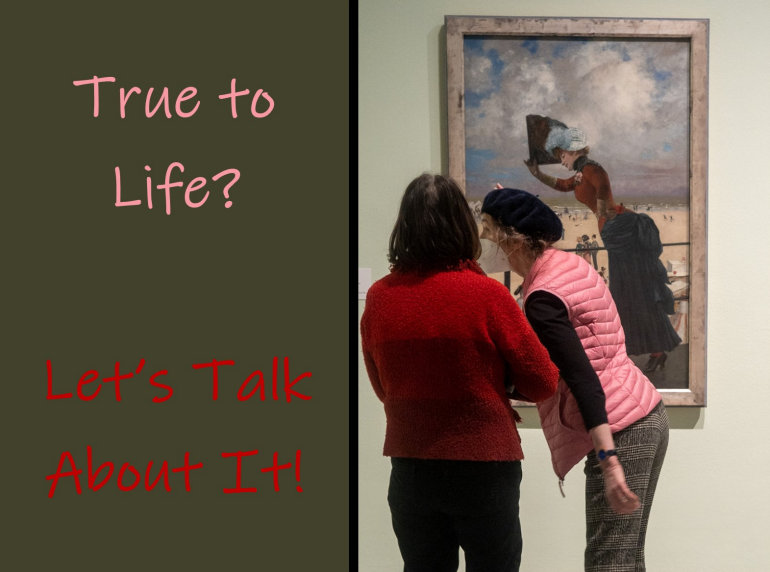ART: The concept of truth-to-life would surely apply more to portraiture than to anything else, for what's the point of a portrait if it's not recognizable? Yet often the sitter wants some kind of idealization or role-playing. The artist may prioritize psychological truth over the physical, or have some other message in mind. And some depictions of people, however accurate, are not intended as portraits at all. rb.

Some questions: Two depictions of Napoleon. What is the Emperor's attitude in each case?
Which picture seems the most realistic in terms of its detail and setting? Which seems the more psychologically realistic?
What image does each artist try to convey? Are both images sanctioned by the sitter? Given that Napoleon ruled France
between 1804 and 1815 (with a brief hiatus) what is the likely date of each version?
PORTRAITS ON FILM: We shall compare the depictions on film of three real-life figures, more
or less linked to our subjects in the first hour: Napoleon (Rod Steiger and Christian Clavier), Chopin (Cornell
Wilde and Hugh Grant), and Emily Dickinson (Cynthia Nixon and Molly Shannon).
PEOPLE: Here are brief bios of the painters and others shown in the class.
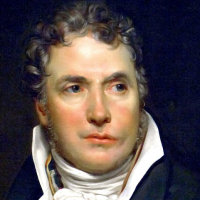 |
Jacques-Louis David, 1748–1825. French painter. The leading Neoclassical artist of his day, David replaced rococo frivolities with stern history paintings with strong moral content. He was a dedicated supporter of the Revolution and politically active as a Deputy. He was imprisoned briefly after the fall of Robespierre, but resurfaced as principal painter to Napoleon. Through his many pupils, he influenced French salon style for a generation. |
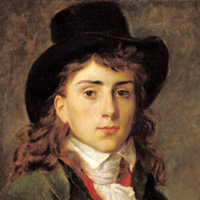 |
Antoine-Jean Baron Gros, 1771–1835. French painter. After studying with David in Paris, Gros moved to Italy. His 1796 painting of Napoleon at Arcole, done while he was there, won him the patronage of the future Emperor, and he traveled with him in many of his subsequent campaigns, besides establishing himself as a portraitist back in Paris. He was ennobled in 1824. |
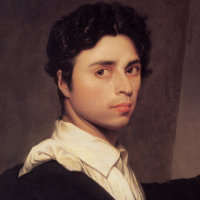 |
Jean-Dominique Ingres, 1780–1867. French painter. Ingres was trained in the academic tradition, and indeed spent 7 years as Director of the French Academy in Rome. Although one of the great masters of French Romantic era, his style was always marked by a cool classicism and precision of line, in contrast to the freer handling of paint by his contemporary Delacroix. |
 |
Horace Vernet, 1789–1863. French painter. A contemporary and friend of Géricault and Delacroix, he specialized in literary, exotic, and increasingly contemporary subjects, known for their free handling and striking color. |
 |
Théodore Géricault, 1791–1824. French painter. Géricault's monumental Raft of the Medusa (1819) was a seminal work in French art, treating a contemporary political scandal with searing humanity coupled with a monumentality that owes much to Michelangelo. His many studies for this work, including corpses and severed limbs, his portraits of the insane, and above all his numerous paintings of horses, made him a key figure in French Romanticism until his death from a riding accident at the age of 32. |
 |
Paul Delaroche, 1797–1856. French painter. Delaroche studied with Gros, but unlike him preferred historical themes to contemporary ones. He favored the rich palette and moody lighting characteristic of Romanticism, but would depict his subjects with a realism that downplayed heroism or glamor in favor of dramatic understanding. |
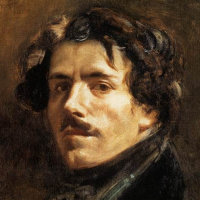 |
Eugène Delacroix, 1798–1863. French painter. The leading French painter of the Romantic movement, he is known for his brilliant Rubensian color and his dramatic compositions. Especially in the first half of his career, these included political themes, such as The Massacre at Chios (1824) and Liberty Leading the People (1830), as well as subjects from Romantic literature. He also visited North Africa, and was constantly fascinated by the exotic. |
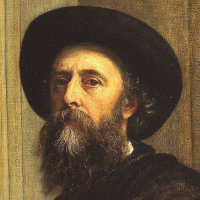 |
George Frederic Watts, 1817–1904. English painter and sculptor. Watts, who once said "I paint ideas, not things," was a British pioneer of the Symbolist movement, and many of his works have allegorical overtones. He was briefly associated with the Pre-Raphaelite Brotherhood, and influenced by DG Rossetti, and even more briefly married to the teenage Ellen Terry, 30 years his junior; Choosing, his 1864 painting of her, remained her favorite portrait. |
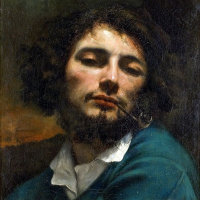 |
Gustave Courbet, 1819–77. French painter. A fiercely realist painter from the provinces who stood proudly outside the academic tradition, Courbet was nonetheless one of the most powerful figures in 19th-century French art. His vast Burial of Ornans was a succès de scandale at the Salon of 1850, and established him as the leader of the Realist movement. |
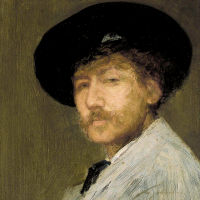 |
James Abbott McNeill Whistler, 1834–1903. American painter, working in London. Whistler's American father was a railroad engineer who took work in Russia when the future artist was still a child, so his training and career took place almost entirely in Europe. He was famous for giving his near-abstract paintings titles such as Arrangement in Grey and Black (the portrait of his mother), thus emphasizing the connection between painting and music. |
ART: For the paintings discussed (or intended to be discussed) in class see below. Scroll to the end or click these links to reach the sections on FILM and BIOS.
COMPARISON 1



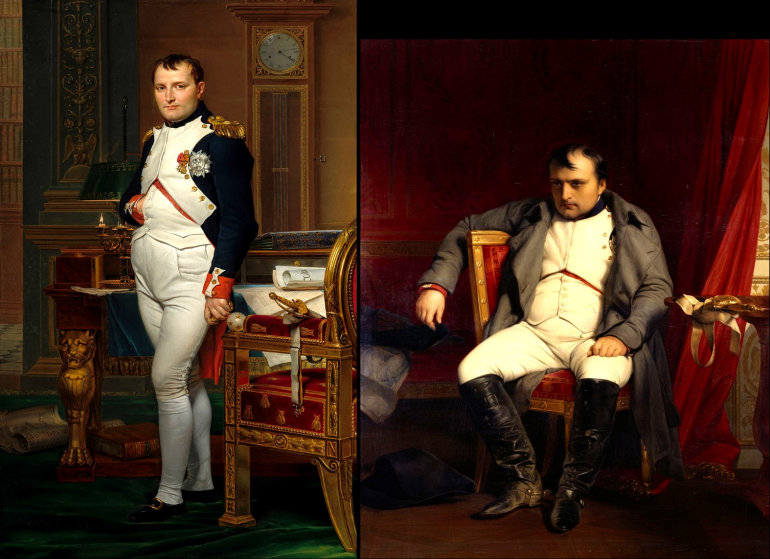
Some questions: Are the three sitters different people, and if not why do they look so similar? Are they approximately the same age, and what would that be? Are all three equally well turned out? What can you say about the style with which they present themselves? Can you guess as to the social class of any of them? Or his profession?
Some facts: The man in yellow appears to be an artist, if the object in front of him is a palette that he is holding, which would make it a self-portrait. It was for a while attributed to Eugène Delacroix (1798–1863), but it looks nothing like his other known self-portraits. Another attribution suggests that it is Delacroix's portrait of the man on the left, his friend Baron Schwiter who, though an aristocrat, was also a painter who exhibited at the Salon for several years. But this too has been dismissed, leaving work a total mystery. The man on the right is certainly an artist, the sculptor Paul Lemoyne, painted by his friend Jean-Auguste-Dominique Ingres (1780–1867) while both were studying in Italy. The similarity between the three is that all are modeling themselves on the aristocratic, slightly disdainful, devil-may-care heroes popularized by Lord Byron, all the rage at the time. If we compare the Lemoyne portrait with a self-portrait by Ingres himself from the same time, we see that he maintained a much more sober self-image, Classicist that he was rather than a Romantic.

Ingres: Self Portrait (1804, Chantilly)
COMPARISON 2




Some questions: I have arranged the pictures in chronological order; what is Napoleon's age in each?At what stage in his career? Which tells us most about the reasons for his success? Which looks most deeply into his mind? Are all three portraits that Napoleon himself might have commissioned? Why are Napoleon's features in the first of them so different from those in the other two?
Some facts: The first portrait, by Antoine-Jean Baron Gros (1771–1835), shows Napoleon as a general of the French Revolutionary Army leading a daring assault on the Bridge at Arcole during his 1796 Italian campaign. The middle one, with Napoleon now Emperor of France, shows him at the height of his powers in his study at the Tuileries, in 1812, before the start of the disastrous Russian campaign. The artist is Jacques-Louis David (1748–1825). The third painting takes place two years later, shortly before Napoleon's first abdication. It is based on a contemporary account of how he locked himself into his sanctum at Fontainebleau, digesting the fact that the wheel of Fate had finally turned against him. Naturally, it was not commissioned by Napoleon, but was painted three decades later in 1846 by Paul Delaroche (1797–1856), who specialized in subjects that were historical rather than contemporary.

David half-length (left) with a computer-generated portrait of Napoleon
Some questions: Here are two other versions of the David picture, one by David himself, and the other by…. Well, what do you think of it?
Some facts: The large image was produced by Dutch photographer Bas Uterwijk, using neural network software which has already been trained to have an understanding of human physiognomy, flesh tones, and so forth. Uterwijk fed into it around two dozen contemporary paintings and sculptures of Napoleon, and guided it as it attempted to compile a composite. It is indeed astonishingly lifelike. The question is whether such truth-to-life is more true than the truth of the best portrait? You can read more about the computer process here.
COMPARISON 3



Some questions: What is the age of the sitter is each portrait? Are they perhaps the same person—and if not, why are their faces so similar? How would she wish to present herself before the world? What does Ingres convey by his choice of setting and accessories in each case? How does he balance design on the surface of the picture against implications of depth?
Some facts: The sitters are indeed different people. Mlle. Caroline Rivière was the daughter of an official in Napoleon's court, and would have been around 14 at the time; Ingres painted the parents as well. The daughter died a year or so later. Louise de Broglie, Comtesse d'Haussonville, came from an old and wealthy artistocratic family. But she was no mere socialite; in later years, she had considerable independent success as a biographer and novelist. Ingres worked for several years on the portrait, interrupted by his sitter's pregnancy, making several sketches in which he tried out small changes in the pose. He still felt he had not done justice to the beauty of his sitter. I have only just noticed the similarity in features, and can't explain it: they are not related, and there is almost 40 years between the pictures, so it can't be a persistent fashion; all I can think of is that it comes from Ingres' own desire to express the beauty of his sitters in terms of a neoclassical ideal.

Ingres: Comtesse d'Haussonville, with sketches
Some questions: What is the difference in effect between the three poses? Is it deliberate that the face in the black and white one is slightly different from the other two? Is the dress in the beige drawing merely a stand-in for the one she would eventually wear, or has Ingres chosen it for a specific effect?
COMPARISON 4




Some questions: Before going into the differences between them, is there anything that these three paintings have in common? Are they all by the same artist? How clearly do you see the physical features of each sitter? How deeply do you see into his mind? Are all three paintings portraits, and if so, do you need to define portrait differently in each case?
Some facts: The center picture is a portrait of the artist Théodore Géricault (1791–1824) by his friend Horace Vernet (1789–1863); it is a true portrait, in that it is a depiction intending to show both the sitter's appearance and something of his character. The other two pictures are by Géricault himself. The one of the black sitter, a model known as Joseph, is one of the many studies he did for his 1919 masterpiece, The Raft of the Medusa, a political scandal in which the officers of a ship abandoned the crew to drift for weeks without food or water. What is remarkable about it is that the artist is not merely studying his sitter's physiognomy but also his depth of emotion. The figure on the left, The Kleptomaniac, is one of several portraits Géricault made of inmates of a mental asylum run by his friend Dr. Georget, with the idea that accurate depiction could be a step towards greater understanding. The next slide shows two others from that series plus a thumbnail of the Raft.

Géricault: The Raft of the Medusa and patients of Dr. Georget
COMPARISON 5



Some questions: How much is each picture concerned with inner feeling as opposed to external appearance? What are those feelings? Are they both of the same person? If these are self-portraits, why do you think the artist represents himself in such extreme ways?
Some facts: Courbet came to Paris in 1839, determined to break with tradition and astonish with a new realism; both self-portraits document a period of intense change in his life.. At the same time, he began to study paintings in the Louvre by Spanish baroque artists and Rembrandt, and these probably influenced the theatricality of The Desperate Man. The Man with a Pipe is about 5 years later, and seems to show a man proud of his rustic provincialism, looking down on city ways.
COMPARISON 6



Some questions: Can you suggest titles for the two pictures? Do you get the sense that the women are people close to the artists, as opposed to hired models? What is the woman doing in each case? Does either action have a meaning beyond what you actually see?
Some facts: Jo Heffernan (1843–1886) was an Irish model who had a six-year affair with painter James Abbott McNeill Whistler (1834–1903), meeting him in London and traveling with him several times to Paris; she was an intellectual as well as sexual companion, and he remembered her in his will. It was on a trip to Paris without Whistler that Jo modeled for Courbet, appearing in several pictures; there is a strong possibility that he was romantically involved as well. The subject of Watts' painting is the actress Ellen Terry (1847–1928). She was already working on the stage, and not yet 17, when the 47-year-old Watts married her in 1864; he hoped to guide her development ino more positive channels. The painting is an allegory, as she chooses the flashy but scentless camellias over the sweet violets hidden in her left hand. Terry treasured the portrait, but the marriage did not last.

Whistler: Symphony in White, No.1 (1862, Washington NGA)
Some questions: In terms of their depiction of the face, how does Whistler differ from Courbet? What is the effect of everything else he puts into the composition? What was Whistler's intent in calling it Symphony in White? To what extent is it really a portrait?
REAL PEOPLE ON FILM: Fortunately, almost all of what I played is available on YouTube, and we can
even get the two Napoleon movies complete. There are many clips from A Song to Remember, but not the scene we
actually saw, so in this case I am providing a trailer. Wild Nights with Emily has an unusually long trailer,
which I haven't watched, but I am confident that it contains enough to show the general approach.
Waterloo, scene played in class
— complete film available here
Napoléon, scene played in class
— complete series available here
A Song to Remember, trailer
Impromptu, scene played in class
A Quiet Passion, scene played in class
Wild Nights with Emily, 10-minute preview
The script for this part of the class can be found here.
PEOPLE: Here are brief bios of the painters and novelists we considered in the class.
 |
Jacques-Louis David, 1748–1825. French painter. The leading Neoclassical artist of his day, David replaced rococo frivolities with stern history paintings with strong moral content. He was a dedicated supporter of the Revolution and politically active as a Deputy. He was imprisoned briefly after the fall of Robespierre, but resurfaced as principal painter to Napoleon. Through his many pupils, he influenced French salon style for a generation. |
 |
Antoine-Jean Baron Gros, 1771–1835. French painter. After studying with David in Paris, Gros moved to Italy. His 1796 painting of Napoleon at Arcole, done while he was there, won him the patronage of the future Emperor, and he traveled with him in many of his subsequent campaigns, besides establishing himself as a portraitist back in Paris. He was ennobled in 1824. |
 |
Jean-Dominique Ingres, 1780–1867. French painter. Ingres was trained in the academic tradition, and indeed spent 7 years as Director of the French Academy in Rome. Although one of the great masters of French Romantic era, his style was always marked by a cool classicism and precision of line, in contrast to the freer handling of paint by his contemporary Delacroix. |
 |
Horace Vernet, 1789–1863. French painter. A contemporary and friend of Géricault and Delacroix, he specialized in literary, exotic, and increasingly contemporary subjects, known for their free handling and striking color. |
 |
Théodore Géricault, 1791–1824. French painter. Géricault's monumental Raft of the Medusa (1819) was a seminal work in French art, treating a contemporary political scandal with searing humanity coupled with a monumentality that owes much to Michelangelo. His many studies for this work, including corpses and severed limbs, his portraits of the insane, and above all his numerous paintings of horses, made him a key figure in French Romanticism until his death from a riding accident at the age of 32. |
 |
Paul Delaroche, 1797–1856. French painter. Delaroche studied with Gros, but unlike him preferred historical themes to contemporary ones. He favored the rich palette and moody lighting characteristic of Romanticism, but would depict his subjects with a realism that downplayed heroism or glamor in favor of dramatic understanding. |
 |
Eugène Delacroix, 1798–1863. French painter. The leading French painter of the Romantic movement, he is known for his brilliant Rubensian color and his dramatic compositions. Especially in the first half of his career, these included political themes, such as The Massacre at Chios (1824) and Liberty Leading the People (1830), as well as subjects from Romantic literature. He also visited North Africa, and was constantly fascinated by the exotic. |
 |
George Frederic Watts, 1817–1904. English painter and sculptor. Watts, who once said "I paint ideas, not things," was a British pioneer of the Symbolist movement, and many of his works have allegorical overtones. He was briefly associated with the Pre-Raphaelite Brotherhood, and influenced by DG Rossetti, and even more briefly married to the teenage Ellen Terry, 30 years his junior; Choosing, his 1864 painting of her, remained her favorite portrait. |
 |
Gustave Courbet, 1819–77. French painter. A fiercely realist painter from the provinces who stood proudly outside the academic tradition, Courbet was nonetheless one of the most powerful figures in 19th-century French art. His vast Burial of Ornans was a succès de scandale at the Salon of 1850, and established him as the leader of the Realist movement. |
 |
James Abbott McNeill Whistler, 1834–1903. American painter, working in London. Whistler's American father was a railroad engineer who took work in Russia when the future artist was still a child, so his training and career took place almost entirely in Europe. He was famous for giving his near-abstract paintings titles such as Arrangement in Grey and Black (the portrait of his mother), thus emphasizing the connection between painting and music. |
